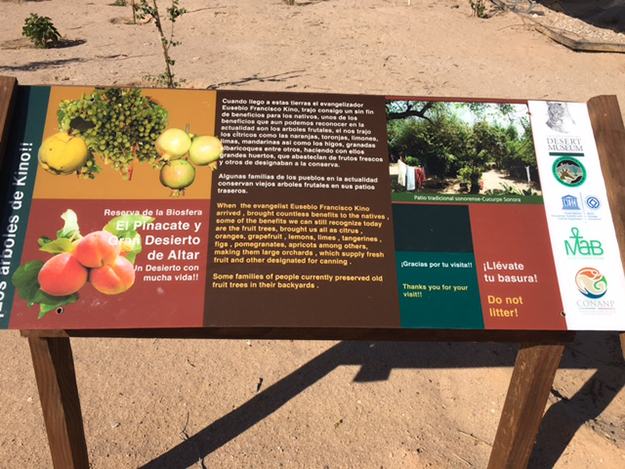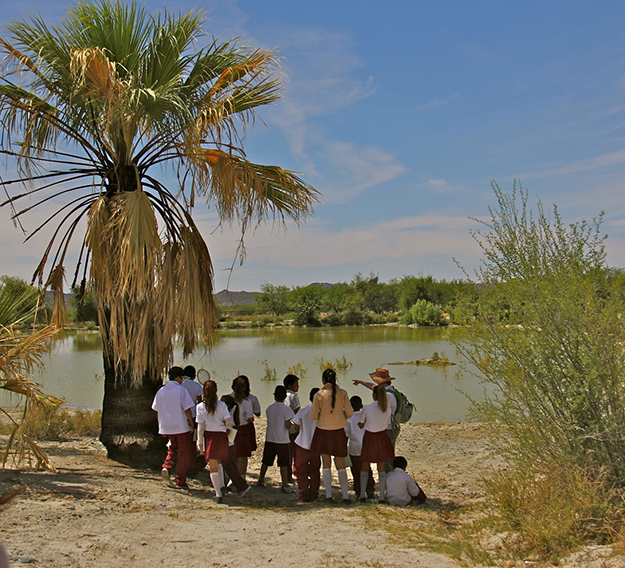
Quitobaquito Oasis, Organ Pipe Cactus National Monument
(Photo by Marie Long)

Partnership meetings at the Tohono O’odham Cultural Center & Museum, Topawa, Arizona
The Ancient Salt Trails and Oases Project
Connecting the Past to the Present
Marie Long & Jesús Manuel García-Yánez, Arizona-Sonora Desert Museum, Peter Holm, Organ Pipe Cactus National Monument, Federico Godinez Leal, Pinacate Biosphere Reserve, Ken Josemaria, Tohono O’odham community member and Doraly Velasco, Tohono O’odham community member of Quitovac.
Ancient Salt Trails and Oases — connecting the past to the present project began in 2015. It is Tri-National collaboration among three organizations: Organ Pipe Cactus National Monument, Pinacate Biosphere Reserve & UNESCO World Heritage Site, the Arizona-Sonora Desert Museum and Tribal community members from the Tohono O’odham Nation. The partnership has better connected the parks to the people of the region and is helping to build stronger relationships by focusing on cultural knowledge of ancient salt trails and the Quitobaquito and Quitovac oases.
Heritage Fruit Trees
Project partners are working together to save heritage fruit trees that once occurred in great abundance at the Quitobaquito oases. Cuttings from the last remaining pomegranate tree at Quitobaquito have been obtained and are being propagated at the Desert Museum. These plants are being held for Organ Pipe National Monument as reserve for future needs in conserving and interpreting the cultural history at Quitobaquito. The Desert Botanical Garden also holds and cares for heritage fruit trees that were collected in1988 by ethnobotanists Gary Nabhan and Wendy Hodgson. A Quitobaquito pomegranate and fig have been planted at the Mission Garden in Tucson and will also be planted at Organ Pipe Cactus National Monument’s Visitor Center in the fall.
As a result of the project, the first Ethnobotanical Garden was established at the Research Station facilities in the Biosphere Reserve El Pinacate. Park staff made several trips to Magdalena de Kino and San Ignacio, Sonora to collect seedlings for the garden. Heritage fruit trees, quinces, pomegranates, peaches, figs, apricots, and other species were planted. The new garden is part of an educational tour that promotes the value and history of ethnobotanical gardens and the contribution of Padre Kino to native cultures.
Tohono O’odham Salt Pilgrimage
In March of 2015 a group of Tohono O’odham men completed the first of four salt pilgrimages that travelled towards Schuk Toak, the Pinacate Mountain range. The new route began from Pisin Mo ‘o (buffalo head) village south through the traditional crossing at Papago Farms and into Mexico. Their destination was the salt fields west of The Pinacate Mountain Range, through the lava fields and the dunes. The total distance was 300 miles to the ocean and back to their starting point.
This pilgrimage was a learning experience, as it was the first time in recent history that a route to the ocean went through the Pinacate Biosphere Reserve. Much knowledge about the route has been lost and this small group of O’odham men is revitalizing these ancient and sacred routes through the land with help from National Park Service staff.
Tohono O’odham — Pinacate Biosphere Reserve Collaborations
The Pinacate Biosphere Reserve is committed to honoring Native peoples that have a connection to the Preserve. There is an agreement between the headquarters of the Reserve and Tohono O’odham and Hia Ced O’odham community members to grant special access to areas within the Preserve that are restricted for public use. Many of these restricted areas are sacred sites to the O’odham.
An important outcome of the project is more opportunity for the Tohono O’odham to access and learn about historic sacred and ceremonial sites. Many of these sites were only known through books and stories. The Pinacate Biosphere Reserve is providing an opportunity for Tribal members to reconnect to the landscape in profound ways, visiting these sacred sites for the very first time. Another outcome of the collaboration is the creation of an area within the Preserve where a traditional ramada will be built and used by Tohono O’odham for their ceremonies.
Schuk Toak Visitor Center Cultural Exhibits & Interpretation
With the goal of strengthening and expanding ancestral cultural elements at the visitor center, Pinacate Biosphere Reserve staff developed a wood engraving workshop in December of 2015. Ten local artists were invited to participate along with 10 community members from the city Puerto Peñasco, Sonora. Stories of the salt pilgrimage were shared with the group of visiting artists. Each artist was asked to interpret the story through their own artistic vision. The goal was to create an elaborate mural to be mounted at the entrance of the visitor center.
A traditional ramada has also been built along the interpretive trail outside of the Schuk Toak Visitor Center. The ramada interprets the traditional culture of the Tohono O'odham and the ancient cultures that inhabited the Pinacate Biosphere Reserve.
These additions have provided visitors an opportunity to learn more about the historic and contemporary lives of the O’odham people of the region.
Quitovac, Sonora, Mexico
The Arizona-Sonora Desert Museum is providing education programs to the school children in Quitovac that focuses on awareness and appreciation of their valuable resource, the oases.
Other Photos

Ethnobotanical garden signage at Pinacate Biosphere Reserve
(Photo by Marie Long)

Lava field at Pinacate Biosphere Reserve
(Photo by Dena Cowan)

Pinacate Biosphere Reserve
cultural exhibition
(Photo by Dena Cowan)

Loads of salt brought across the border from the Gulf of California by Tohono O’odham. March 20, 1935.
(Photo by Ed Ketchum, courtesy of Bill Broyles)

Pinacate Biosphere Reserve Schuk Toak Visitor Center mural project
(Photo by Marie Long)

Pinacate Biosphere Reserve Schuk Toak Visitor Center Interpretive Ramada
(Photo by Dena Cowan)




